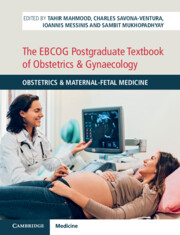Book contents
- The EBCOG Postgraduate Textbook of Obstetrics & Gynaecology
- The EBCOG Postgraduate Textbook of Obstetrics & Gynaecology
- Copyright page
- Dedication
- Contents
- Contributors
- Preface
- Section 1 Basic Sciences in Obstetrics
- Section 2 Early Pregnancy Problems
- Section 3 Fetal Medicine
- Section 4 Maternal Medicine
- Chapter 25 Hypertensive Disorders in Pregnancy and Eclampsia
- Chapter 26 Obesity and Metabolic Syndrome in Pregnancy
- Chapter 27 Screening for Gestational Diabetes Mellitus and Care of Diabetes Mellitus in Pregnancy
- Chapter 28 Cardiac Disease in Pregnancy
- Chapter 29 Respiratory Disease in Pregnancy
- Chapter 30 Thromboembolism in Pregnancy
- Chapter 31 Haemoglobinopathies in Pregnancy
- Chapter 32 Kidney Diseases in Pregnancy
- Chapter 33 Gastrointestinal Disorders in Pregnancy
- Chapter 34 Systemic Lupus Erythematosus and Pregnancy
- Chapter 35 Autoimmune Rheumatic Disorders in Pregnancy
- Chapter 36 Thyroid Disease in Pregnancy
- Chapter 37 Infections in Pregnancy
- Chapter 38 HIV Infection in Pregnancy
- Chapter 39 Acute Management of Sepsis in Pregnancy
- Chapter 40 Psychological Disorders in Pregnancy
- Chapter 41 Pregnancy after Solid Organ Transplantation
- Chapter 42 Oral Health and Periodontal Diseases in Pregnancy
- Section 5 Intrapartum Care
- Section 6 Neonatal Problems
- Section 7 Placenta
- Section 8 Public Health Issues in Obstetrics
- Section 9 Co-Morbidities during Pregnancy
- Index
- Plate Section (PDF Only)
- References
Chapter 31 - Haemoglobinopathies in Pregnancy
from Section 4 - Maternal Medicine
Published online by Cambridge University Press: 20 November 2021
- The EBCOG Postgraduate Textbook of Obstetrics & Gynaecology
- The EBCOG Postgraduate Textbook of Obstetrics & Gynaecology
- Copyright page
- Dedication
- Contents
- Contributors
- Preface
- Section 1 Basic Sciences in Obstetrics
- Section 2 Early Pregnancy Problems
- Section 3 Fetal Medicine
- Section 4 Maternal Medicine
- Chapter 25 Hypertensive Disorders in Pregnancy and Eclampsia
- Chapter 26 Obesity and Metabolic Syndrome in Pregnancy
- Chapter 27 Screening for Gestational Diabetes Mellitus and Care of Diabetes Mellitus in Pregnancy
- Chapter 28 Cardiac Disease in Pregnancy
- Chapter 29 Respiratory Disease in Pregnancy
- Chapter 30 Thromboembolism in Pregnancy
- Chapter 31 Haemoglobinopathies in Pregnancy
- Chapter 32 Kidney Diseases in Pregnancy
- Chapter 33 Gastrointestinal Disorders in Pregnancy
- Chapter 34 Systemic Lupus Erythematosus and Pregnancy
- Chapter 35 Autoimmune Rheumatic Disorders in Pregnancy
- Chapter 36 Thyroid Disease in Pregnancy
- Chapter 37 Infections in Pregnancy
- Chapter 38 HIV Infection in Pregnancy
- Chapter 39 Acute Management of Sepsis in Pregnancy
- Chapter 40 Psychological Disorders in Pregnancy
- Chapter 41 Pregnancy after Solid Organ Transplantation
- Chapter 42 Oral Health and Periodontal Diseases in Pregnancy
- Section 5 Intrapartum Care
- Section 6 Neonatal Problems
- Section 7 Placenta
- Section 8 Public Health Issues in Obstetrics
- Section 9 Co-Morbidities during Pregnancy
- Index
- Plate Section (PDF Only)
- References
Summary
Haemoglobinopathies constitute a heterogeneous group of autosomal recessive inherited disorders, affecting either haemoglobin synthesis (i.e. thalassaemia) or structure (i.e. sickle cell disease) [1], and they represent the most common single-gene disorder in humans [2]. According to the World Health Organization (WHO), about 5% of the world’s population are carriers of a potentially pathological haemoglobin gene. Annually, about 300 000 infants are born all around the world with a dominant haemoglobinopathy, with 30% of them suffering from thalassaemia syndromes and the remaining 70% from sickle cell anaemia [3]. Sickle cell disease appears to be more prevalent in Africa, α-thalassaemia in South East Asia and β-thalassaemia in the Mediterranean, Middle East and Asia. This geographic allocation is due to the fact that individuals carrying one pathological and one normal gene (heterozygous carriers trait) were protected from malaria, and these regions had the highest prevalence of this fatal disease.
- Type
- Chapter
- Information
- The EBCOG Postgraduate Textbook of Obstetrics & GynaecologyObstetrics & Maternal-Fetal Medicine, pp. 252 - 259Publisher: Cambridge University PressPrint publication year: 2021

